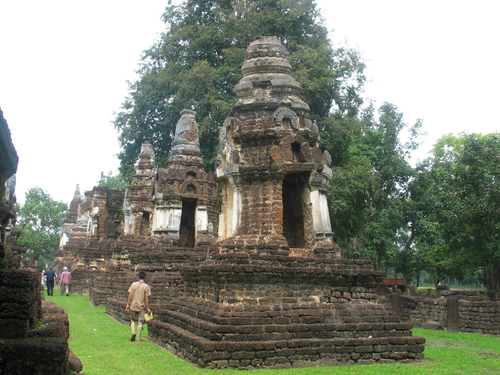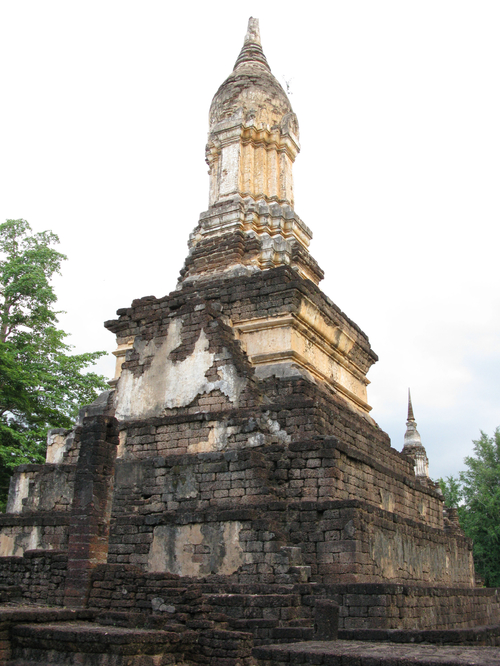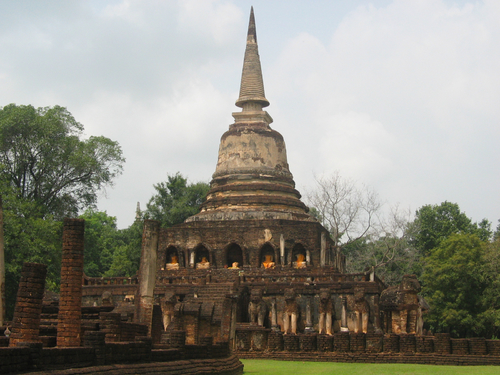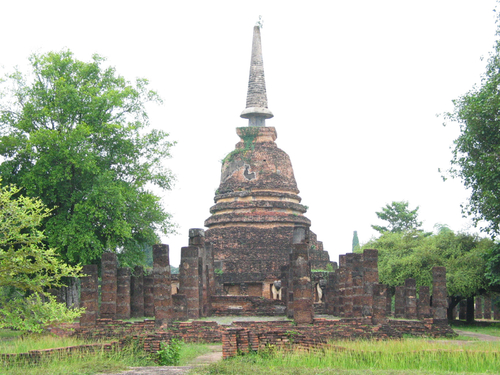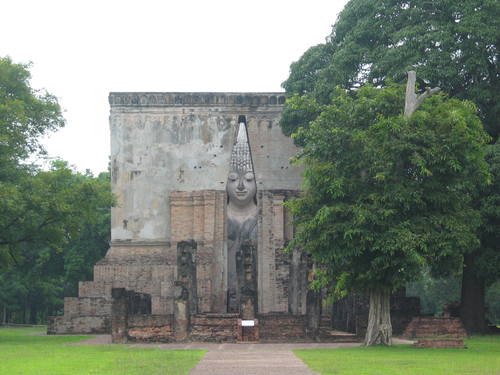ค้นหางานศิลปกรรม
ฐานข้อมูลศิลปกรรมในเอเชียตะวันออกเฉียงใต้
สถาปัตยกรรมเจดีย์รายทรงปราสาทยอดวัดเจดีย์เจ็ดแถว
เจดีย์รายทรงปราสาทยอดตั้งเรียงรายรอบๆ เจดีย์ประธานและวิหาร ก่อด้วยศิลาแลง ฉาบปูน และประดับปูนปั้น องค์ประกอบโดยรวมประกอบด้วยส่วนฐาน เรือนธาตุ และยอด โดยส่วนฐานมีฐานบัวในผังสี่เหลี่ยมเป็นส่วนสำคัญ ถัดขึ้นไปเป็นเรือนธาตุในผังเพิ่มมุมหรือย่อมุม ด้านตะวันออกเป็นทางเข้าสู่ห้องคูหา ส่วนด้านอื่นๆ เป็นซุ้มจระนำประดิษฐานพระพุทธรูป ส่วนยอดเป็นชั้นซ้อน 2 ชั้น ต่อด้วยระเบียบของเจดีย์ทรงกลมศิลปะสุโขทัย คือ บัวถลา บัวปากระฆัง องค์ระฆัง และส่วนยอดสุดที่พังทลายแล้ว
สถาปัตยกรรมเจดีย์ประธานวัดเจดีย์เจ็ดแถว
เจดีย์ประธานวัดเจดีย์เจ็ดแถวตั้งอยู่กลางเขตพุทธาวาส ก่อศิลาแลงและฉาบปูน องค์ประกอบสำคัญตั้งแต่ส่วนฐานจนถึงยอดมีดังนี้ ฐานเขียงในผังสี่เหลี่ยมจัตุรัสซ้อนลดหลั่นกันต่อด้วยฐานบัวลูกแก้วอกไก่ในผังสี่เหลี่ยมจัตุรัส มีบันไดอยู่ทางด้านตะวันออก ถัดขึ้นไปเป็นฐานบัวลูกฟักเพิ่มมุมหรือย่อมุมซ้อนกัน 2 ชั้น ถัดขึ้นไปเป็นเรือนธาตุในผังเพิ่มมุมหรือย่อมุม จากนั้นเป็นส่วนยอดทรงดอกบัวตูมหรือทรงพุ่มข้าวบิณฑ์
สถาปัตยกรรมเจดีย์วัดช้างล้อมศรีสัชนาลัย
เจดีย์ช้างล้อมองค์นี้ใช้ศิลาแลงและปูนเป็นวัสดุหลัก องค์เจดีย์ทรงกลมตั้งอยู่บนฐานประทักษิณสี่เหลี่ยมจัตุรัส มีบันไดทางขึ้นสู่ลานประทักษิณทางด้านตะวันออกหรือด้านหน้า มีประติมากรรมรูปช้างลอยตัวจำนวน 39 เชือกล้อมรอบฐานทักษิณนี้ ระหว่างช้างแต่ละตัวมีเสาตามประทีปคั่นกลาง เจดีย์ที่ตั้งอยู่บนลานประทักษิณมีองค์ประกอบสำคัญจากด้านล่างสู่ด้านบน ได้แก่ ฐานสี่เหลี่ยมจัตุรัสที่มีซุ้มจระนำประดิษฐานพระพุทธรูปปูนปั้นด้านละ 5 ซุ้ม รวมเป็น 20 ซุ้ม ส่วนนี้เป็นรูปแบบพิเศษของเจดีย์องค์นี้ ถัดขึ้นไปเป็นรูปแบบโดยทั่วไปของเจดีย์ทรงกลมศิลปะสุโขทัย คือ ฐานเขียงซ้อนลดหลั่นกันต่อด้วยชุดบัวถลา 3 ชั้น บัวปากระฆัง องค์ระฆังกลม บัลลังก์ และส่วนยอด
สถาปัตยกรรมเจดีย์วัดศรีพิจิตรกีรติกัลยาราม
เจดีย์ประธานวัดศรีพิจิตรกีรติกัลยารามเป็นงานก่ออิฐถือปูน มีส่วนฐานที่สูงใหญ่ ซึ่งเชื่อว่าเป็นรูปแบบหนึ่งของศิลปะสุโขทัยระยะปลาย รายละเอียดของส่วนต่างๆ มีดังนี้ ฐานสูงใหญ่อันประกอบฐานเขียงซ้อนลดหลั่นกัน ด้านตะวันออกก่ออิฐเว้าเป็นซุ้มประดิษฐานพระพุทธรูป ส่วนด้านอื่นทำเป็นมุขยื่นออกมา ถัดขึ้นไปเป็นฐานบัวซ้อนกันสองชั้น เจดีย์ทรงกลมตั้งอยู่ด้านบนของชุดฐานนี้ โดยรูปแบบทั่วไปเป็นไปตามแบบแผนศิลปะสุโขทัย ประกอบด้วยฐานเขียงซ้อนลดหลั่นกัน ถัดขึ้นไปเป็นบัวถลา องค์ระฆัง บัลลังก์ และส่วนยอด
สถาปัตยกรรมเจดีย์วัดช้างล้อมสุโขทัย
เจดีย์ประธานวัดช้างล้อมตั้งอยู่กลางเขตพุทธาวาส ก่ออิฐฉาบปูน ล้อมรอบด้วยระเบียงคดโถง ด้านหน้าหรือด้านตะวันออกมีวิหารสี่เหลี่ยมผืนผ้าตั้งอยู่ ส่วนฐานของเจดีย์ประดับด้วยประติมากรรมรูปช้างที่ทำเพียงครึ่งตัวยืนอยู่ภายในซุ้ม ถัดขึ้นไปเป็นชุดฐานเขียงซ่อนลดหลั่นกัน ต่อด้วยบัวถลา 3 ชั้น องค์ระฆัง บัลลังก์ และส่วนยอด
สถาปัตยกรรมมณฑปวัดตระพังทองหลาง
มณฑปวัดตระพังทองหลางตั้งอยู่กึ่งกลางวัด เป็นอาคารก่ออิฐถือปูนแผนผังสี่เหลี่ยมจัตุรัส หลังคาไม่เหลือร่องรอยแล้ว เชื่อว่าเพราะทำจากเครื่องไม้มุงด้วยกระเบื้อง เมื่อเวลาผ่านไปจึงปรักหักพังลง ภายในประดิษฐานพระพุทธรูปก่ออิฐถือปูน มีทางเข้าอยู่ทางด้านตะวันออก ส่วนด้านเหนือ ตะวันตก และใต้ มีจระนำประดับภาพปูนปั้นเล่าเรื่องพุทธประวัติ ด้านเหนือเป็นตอนโปรดช้างนาฬาคีรี ด้านตะวันตกเป็นตอนแสดงยมกปาฏิหาริย์ ณ เมืองสาวัตถี และด้านใต้เป็นตอนเสด็จลงจากสวรรค์ชั้นดาวดึงส์ ด้านหน้าของมณฑปมีวิหารสี่เหลี่ยมผืนผ้า เหลือแต่ฐานและแนวเสา เข้าใจว่าคงเป็นวิหารโถง หลังคาคงเป็นเครื่องไม้มุงด้วยกระเบื้องได้หักพังลงหมดแล้ว
สถาปัตยกรรมมณฑปวัดศรีชุม
มณฑปอยู่ในผังสี่เหลี่ยม หันหน้าไปทางทิศตะวันออก มีพระพุทธรูปปูนปั้นปางมารวิชัยประดิษฐานอยู่ภายใน มีอุโมงค์ทางเดินอยู่ภายในผนังของมณฑป อุโมงค์นี้ไต่ระดับขึ้นไปจนถึงยอด ภายในอุโมงค์ประดับตกแต่งด้วยภาพสลักเรื่องชาดก การทำอุโมงค์ระหว่างผนังและสามารถเดินไปถึงด้านบนได้เช่นนี้อาจเกี่ยวข้องกับสถาปัตยกรรมพม่าสมัยเมืองพุกาม ส่วนยอดของมณฑปพังทลายลงแล้ว มีแนวสันนิษฐานไว้สองแบบ แบบแรกเชื่อว่าเป็นหลังคาเครื่องไม้มุงด้วยกระเบื้อง แบบที่สองเชื่อว่าเป็นเจดีย์ทรงกลม
สถาปัตยกรรมมณฑปพระสี่อิริยาบถ
สภาพปัจจุบันของมณฑปพระสี่อิริยาบถเหลือให้เห็นเฉพาะอิฐที่เป็นแกนกลางของมณฑป หลังคาเครื่องไม้มุงกระเบื้องพังทลายลงแล้ว ด้านทิศตะวันออกประดิษฐานพระพุทธรูปปางลีลา ด้านทิศตะวันตกประดิษฐานพระพุทธรูปประทับยืน ด้านทิศเหนือประดิษฐานพระพุทธรูประทับนั่ง และด้านทิศใต้ประดิษฐานพระพุทธรูปประทับนอน พระพุทธรูปทั้งสี่องค์เป็นงานก่ออิฐฉาบปูนแบบนูนสูง โดยด้านหลังของพระพุทธรูปแต่ละองค์อิงติดกับแกนกลางของมณฑป
